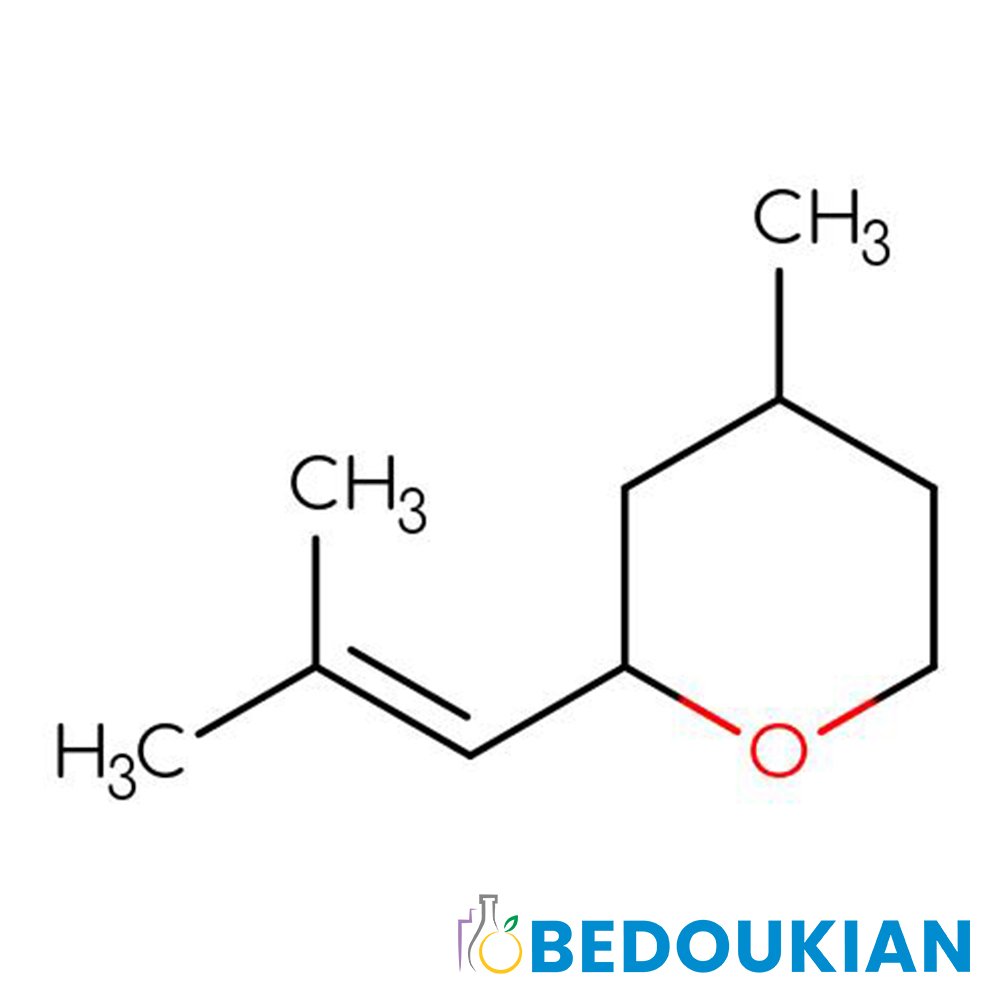Rose Oxide
Premium Synthetic Ingredient for Perfumery
Rose Oxide BRI is a synthetic fragrance compound developed by Bedoukian Research Inc., used primarily in rose and geranium-type accords. It imparts a weak yet complex floral-metallic scent, dominated by sharp green notes and a distinctive iron-like nuance. Often associated with the smell of dried blood or oxidized metal, Rose Oxide introduces realism, sharpness, and edge to floral blends. The material is a mixture of stereoisomers, with distinct olfactory variations among them.
Bedoukian’s version (BRI 480) offers trace-level floral modulation with specific application in fine fragrance and flavor.
Premium Synthetic Ingredient for Perfumery
Rose Oxide BRI is a synthetic fragrance compound developed by Bedoukian Research Inc., used primarily in rose and geranium-type accords. It imparts a weak yet complex floral-metallic scent, dominated by sharp green notes and a distinctive iron-like nuance. Often associated with the smell of dried blood or oxidized metal, Rose Oxide introduces realism, sharpness, and edge to floral blends. The material is a mixture of stereoisomers, with distinct olfactory variations among them.
Bedoukian’s version (BRI 480) offers trace-level floral modulation with specific application in fine fragrance and flavor.
Premium Synthetic Ingredient for Perfumery
Rose Oxide BRI is a synthetic fragrance compound developed by Bedoukian Research Inc., used primarily in rose and geranium-type accords. It imparts a weak yet complex floral-metallic scent, dominated by sharp green notes and a distinctive iron-like nuance. Often associated with the smell of dried blood or oxidized metal, Rose Oxide introduces realism, sharpness, and edge to floral blends. The material is a mixture of stereoisomers, with distinct olfactory variations among them.
Bedoukian’s version (BRI 480) offers trace-level floral modulation with specific application in fine fragrance and flavor.
Synthetic Ingredient Overview
🏭 Manufacturer: Bedoukian Research Inc.
🔎 IUPAC Name: Cis-2-(2-Methyl-1-propenyl)-4-methyltetrahydropyran (mixture of isomers)
🧪 Synonyms: Rose Oxide, Rose Oxide BRI
🧬 Chemical Formula: C₁₀H₁₈O
📂 CAS N°: 16409-43-1
📘 FEMA: 3236
⚖️ Molecular Weight: 154.24 g/mol
📝 Odor Type: Floral-Green-Metallic
📈 Odor Strength: Weak, trace-use only
👃🏼 Odor Profile: Rosy, metallic, green, iron-like, with dusty-medicinal facets and a pea-skin nuance
⚗️ Primary Uses: Floral modifiers in rose, geranium, raspberry, and metallic accords
🧴 Appearance: Clear, colorless liquid
What is Rose Oxide?
Rose Oxide is a stereochemically complex fragrance compound first isolated in 1959 from Bulgarian rose oil. Modern commercial versions, including BRI’s Rose Oxide, are synthesized and consist of a mixture of stereoisomers (cis/trans, dextro/laevo) that each contribute subtle variations in odor:
Laevo-cis: Sweeter, greener, softer
Dextro-cis: Spicier, herbaceous, slightly gassy
Trans isomers: Sharper, less diffusive
These stereoisomers cannot be easily separated, and most commercial materials contain mixtures, giving Rose Oxide its signature blend of floral, metallic, and herbal tones. BRI's version is used primarily for trace-level floral modification, especially where natural rose or geranium oils need added dimensionality.
Olfactory Profile and Perfumery Applications
Despite its low intrinsic odor strength, Rose Oxide BRI is powerful in trace use, capable of dramatically modifying the character of rose and green compositions.
Floral function: Enhances realism and metallic lift in rose and geranium bases
Green effects: Adds pea-skin and leaf-like top-note freshness
Metallic nuance: Contributes sharpness and oxidative realism; useful in aldehydic or modern transparent florals
Emotive undertones: The iron/dusty character suggests natural blood or rust notes, giving texture and depth
Recommended for:
Rose, geranium, and cyclamen accords
Raspberry and blackberry-type fantasy fruits
Niche and experimental compositions seeking metallic realism
Flavor Use
Rose Oxide is also FEMA-approved for use in flavoring:
Flavor profile: Green, rosy, woody
Use level: 0.1–10 ppm
Target notes: Raspberry, blackberry, red berry bases, fruity top notes
Its metallic-green tonality brings realism and freshness to fruit flavorings when used sparingly.
Regulatory and Safety Overview
IFRA: No specific restrictions under IFRA 51st Amendment
EU Allergens: Not listed among the 26 declarable allergens
FEMA GRAS: FEMA 3236 – approved for use in flavorings within regulated ppm limits
ECHA (REACH): Registered; not classified as hazardous under CLP
Toxicology: No evidence of sensitization at recommended use levels
Environmental Profile: Not classified as PBT or vPvB
✅ Safe for trace-level use in both perfumery and flavor applications; formulation testing advised due to stereoisomer complexity.
Sources
Bedoukian Research Inc. – Product Code 480, Rose Oxide BRI
Perfume and Flavor Chemicals, S. Arctander (1969)
FEMA GRAS Database – Entry 3236
Fulvio Ciccolo, Scentspiracy Research Notes (2022)
NCBI Compound Summary for Rose Oxide – Stereoisomeric Analysis
Internal BRI Sample Archive – Rose Oxide, Flavor & Fragrance Applications

